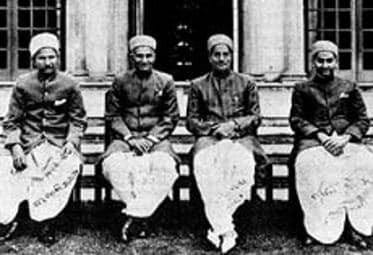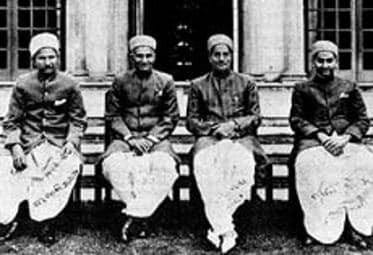A look at Marwari Businessmen in India
The Marwari community exemplifies business resilience, with a deep-rooted tradition of entrepreneurship, collaboration, intergenerational wealth transfer and a shared goal of wealth creation.
Even in the face of a slowdown, there are certain business houses that remain strong and continue to increase their market share. It’s a dream of every financial analyst, fund manager and even wealth managers to have early access to such businesses in their client’s portfolios either through direct equity or mutual funds. Hence, you will find a lot of people from our industry (financial services) use the word ‘moat’ consistently in order to outperform the industry benchmark or their peers. Moat simply means the ability of the company to generate cash flows in excess of cost of capital.
There are ample of books written on identifying such businesses through valuation models that extensively use numbers to define one part of the story. But then there is also a qualitative part of the story that can’t be defined in numbers alone. It’s about the promoter or management of the company that is somehow just better than most of its competition. And sometimes so much better that we tend to simply say, ‘it’s genetic’ or ‘business is in their genes’ as we don’t know how to quite define it.
As I was going through some blogs that my industry colleagues had written, I bumped into a blog that recommended a book called ‘The Marwaris’ written by Thoms Timberg. Being a bookwork, I quickly ordered the book and started reading it. A fascinating book that covers the history of the Marwari community and their innate business talent. A fact that intrigued me is that there are fewer than 9 million marwaris in India but their presence in business community of India cannot go unnoticed. In 2014, Forbes came out with Top 100 Listed Marwari Owned Companies.
“…read the sub-text and you will find that it spells ‘family’. It is the tie that has underpinned these businesses and is, often self-admittedly, the force that powers the risk-takers to…take risks….the Marwaris take the family in ‘family-owned business’ seriously. The most powerful industrialist will, even in the boardroom, rush to touch an elder relative’s feet as a greeting. Deferring to the older generation may be an archaic notion, but it is also a sign of respect that prevents the delicate balance of commerce and emotion from unravelling…” – Abhilasha Khaitan in the 17th March 2014 edition of Forbes India
Traditionally, Marwari community were engaged in speculation of commodities. Big business names like Jagat Seth, G.D. Birla, Goenkas,etc.. have made their fortunes trading opium in the Pre-Independent India. Although what makes the community interesting is the fact that they have been able to carry this fortune for multiple generations and have continued to expand as their families grew. They have also diversified their business interest from commodity traders to leading industrialists of India.
So what makes the Marwari tick all the right boxes and pass on their business to several generations altogether?
One answer to this is about their sense of collaboration within the community and sense of inclusiveness for the next generation.
Their sense of collaboration can be understood from the fact that how quickly they are able to regroup in an absolutely new environment. If one person comes to Mumbai from their village looking for a job, he will work with a Marwari businessman. Slowly, he will set up his own shop and call his family as well. Then follows relatives who too first work with him and then slowly set up their own shops. This might look like a long process but in a span of 15-20 years, there will be more than 5 Marwari families settled in Mumbai whose source can be traced back to that one person who came looking for work.
It’s a common trend that by the age of 10-12, the next generation starts to sit at the shops or offices learning the tricks of trade first hand. By the time they are 24, which is officially an age where most Indians start working after their post-graduation, these Marwari boys would have garnered more than 12-15 years of part time work experience. Malcom Gladwell, the famous author of the book Outliers, that promote 10,000 hours rule to master a subject will look at this system in awe too.
Several centuries before the term ‘to network’ became a verb, the Marwari community had understood the power of co-operation and collaboration across vast networks. In common with what the Jews did in Europe, the Marwaris therefore groomed their children in a specific way (from the book: The Marwaris)
“Communities and castes with a history of involvement in business orient their children…to the trade, applaud success and know how to help each other in business. It is for this reason that the psychological make-up of those who run businesses in crowded markets is often marked by n-affiliation (a psychological orientation to work social networks, as politicians do) rather than n-achievement [refers to an individual’s desire for significant accomplishment, mastering of skills, control, or high standards]. In a study of small engineering shop owners in Howrah, Raymond Owens demonstrated that members of the Mahasiya caste, who were prominent among owners of shops, had high n-affiliation since their business success was dependent on networking with caste fellows. The other entrepreneurs who came from a wide variety of castes, usually upper-class ‘service castes’ (Brahmins, Kshatriyas, Baidyas), had high n-achievement…Everything in the environment of these young Marwari men assisted them in being successful in business. They had a first-class support network constituted by their traditional family firms, business groups and the community. When they arrived in a new place, they found a basa, which provided boarding, lodging and society. Their friends and relatives were already in business and could help them.”
Not only that, they have understood the power of sharing of profits with different stakeholders of the business even before the famous MBA colleges started vouching for it. Sharing of profits through incentives may well be a new concept to the West but Indian Marwari business houses had been practicing it over a hundred years ago, and long before agency theory was developed by academics in American business schools, the Great Marwari Firms which controlled trade in India’s Ganga-Yamuna flood plains had created a system of incentives which aligned their managers’ interests with the promoters’.
“Until the First World War, the Tarachand Ghanshyamdas office or gaddi at 18, Mullick Street in Calcutta took up an entire floor….There were 89 clerks working there. The head manager, Chhaganlal Bhavsinghka, was paid the princely sum of Rs 250 a month…Besides their pay, the managers often received a share in the profits of the firm. Jainarain Poddar, the chief manager, testified in court that he received Rs 2-3 lakhs annually over a period of several years, probably his share of profits. Other branch managers had variously defined share of profits. The exact arrangements differed from firm to firm.”
One more thing that Marwaris did right was that they promoted their managers too. Infact, some of their managers owned their own rice, jute or dal mills. There was a sense of loyalty and entrepreneurship imbedded in the system. Hence, everyone who was a part of the system got immensely wealthy. It was clear and common goal for all the stakeholders in a business, they wanted to get wealthy and they did.
From a layman’s point of view:
When we look at such business houses that have a clear goal, alignment of interest, profit sharing mechanisms, passion for entrepreneurship, grooming the next generation from an early age and create a wide network of business and social relations within the community. One can be sure that such businesses rarely fail.
For a business to grow it needs an influx of talent, networks and capital. Which is vastly present in Marwari community! Infact, I was speaking with my Marwari friend about how to get wealthy in business when the network of business or social relations within the community is absent? His answer surprised me, he said – it’s simple, marry a rich Marwari girl. The answer may sound hilarious but then it seems to be working for them.
It’s no rocket science to conclude that it’s this thick bond of networks along with talent, Marwari community has continued to grow despite any economic shocks. Their moat is their relationship management which is a skill that is very difficult to put it in numbers.
There is a lot more to learn from various communities in India for the next generation who is taking up jobs in lieu of a secure future. But what is a sense of security for a person is a question that each person has to answer for themselves? Is it monthly guaranteed paycheck or a network of relationships where everyone has a clear goal to get wealthy together?




